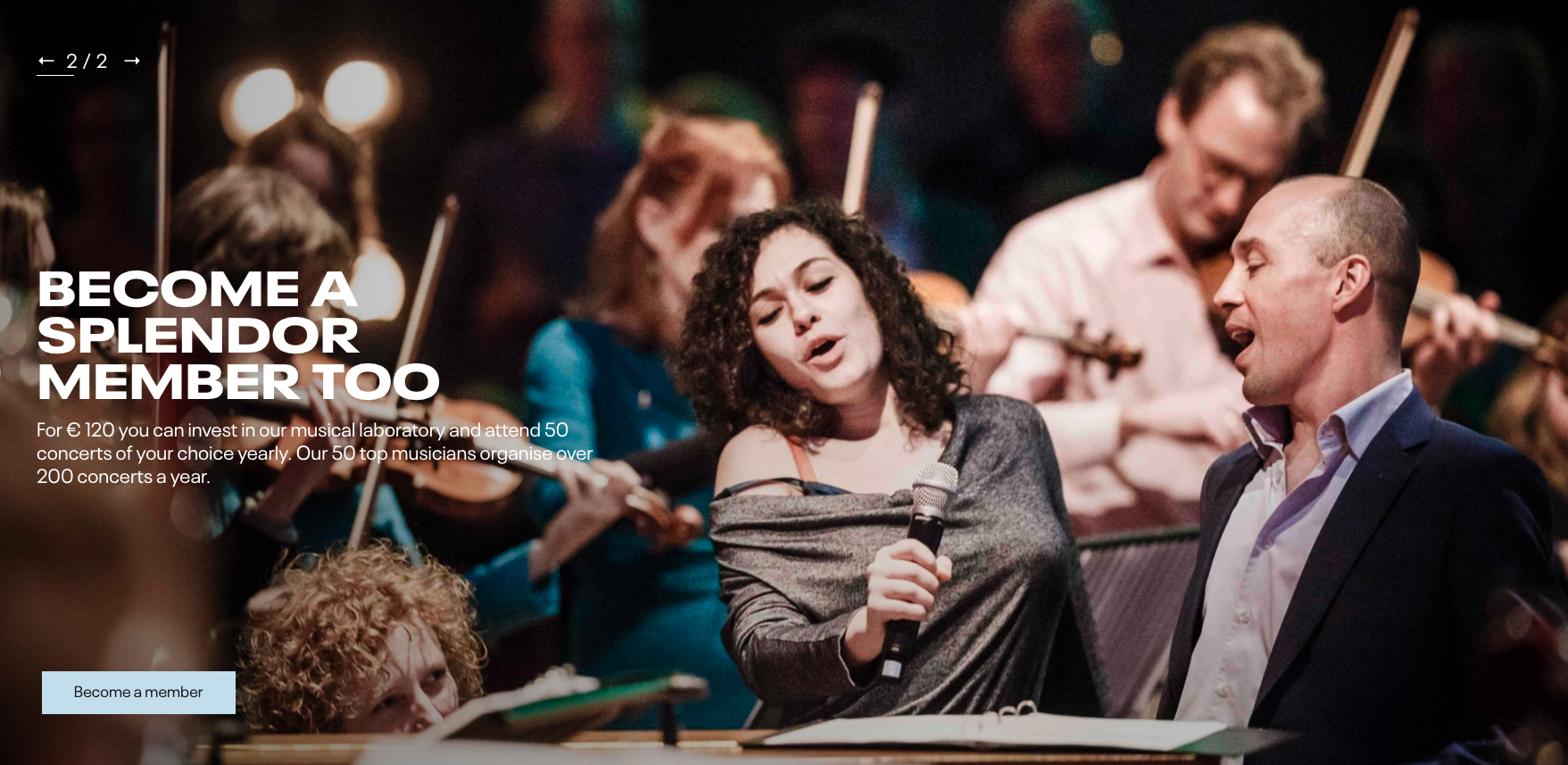Since 2013, Splendor Amsterdam unites composers, musicians and stage artists, that came together to form an artist-run cooperative that independently exploits a music venue in which the musicians have complete autonomy. In this initiative, an old centrally located Amsterdam bathhouse was transformed into a professionally equipped music house, which is operated in its entirety by a group of 50 top-flight professional musicians (among which players of the main Dutch orchestras such as the Concertgebouw Orchestra, Rotterdam Philharmonic and the Radio Orchestras, as well as names from the world of opera, jazz, electronics and ethnic music) that felt the necessity for having a place for experimentation outside of their normal orchestras in which opportunities for artistic innovation can be limited.
In their organizational model, all aspects of the organization (from acquiring finances to musical programming) are shared among all members. As such, the organization can be seen as a ‘cultural common’: it provides a value for a group of users, as long as it is sustained by the same group. In the case of Splendor, this comes together in the two main elements of its business model: a strive for complete artistic freedom and autonomy, and a collectively shared sense of ownership and responsibility.
Financial model
In order to make the Splendor business model financially viable, the organization has developed a financial model that is dependent on different types of income. The city of Amsterdam carried the renovation costs of the building, which they in return rent out to the Splendor organization. However, as a start-up investment, Splendor needed €300.000 for further adaptations to the building, and for the purchase and installation of materials. Utilizing the cooperative rationale, the initial capital input came from the 50 musicians, who each invested €1.000 in the form of a corporate bond, giving the organization an instant, one-time capital input of €50.000. The remaining €250.000 was raised through private investors, who in return for providing capital – in the form of purchasing a ten-year bond – received a private concert by one or some of the musicians at home as dividend. Operational costs are covered by a combination of individual ticket sales for concerts (of which 70% goes to the organizing musician, and 30% to the venue) and income coming from the approximately 1200 Splendor members. For a yearly contribution of €120, these public members are entitled to a number of free concerts. Finally, income through the in-house exploitation of food and beverages goes to the venue.
The organizational form of Splendor is that of a foundation, consisting of two parallel layers: the musicians on the one hand, and a facilitating small management team (composed of all trained musicians) that support daily operations on the other. As artistic autonomy is at the core of the project, all artistic decisions are distributed among all musicians, exemplifying a genuine form of shared leadership. The group of musicians display a high degree of diversity, both in terms of instruments as well as in musical styles employed. On the one hand, this diversity offers unique opportunities for cross-fertilized artistic innovation through unexpected combinations. Moreover, this also provides possibilities to fully utilize the venue’s capacity and opportunities, as various musicians tend to use the building in different ways, and on different moments of the week (e.g. some concerts are more suited for a Sunday afternoon, while others might be more appropriate for a Friday night). Additionally, the diversity of musicians combined with their connection to established institutions (e.g. large orchestras) provides Splendor with a large and diverse audience base.
Artistic freedom and autonomy
The first and foremost goal of Splendor is to create an environment with complete artistic independence. As a general rule, Splendor does not make a formal procedure for something unless it is absolutely required. Splendor was meant to be a place free of institutional and artistic boundaries, where anything is possible and appreciated. In terms of musical content, there are no limitations: repertoire and newly composed avant-garde music are equally welcomed, as well as experimentation in content, concept and artist-audience relationship is embraced. Such a place was missing in the Amsterdam musical landscape: “We needed somewhere to play little ideas, and make small concerts. That was important. And maybe a place to work” Van Dartel states.
Based on this premise of artistic autonomy, Splendor has made several business model decisions that enables the organization to further exploit their vision. First, Splendor has decided to employ a ‘no-programming program’ for the venue. Splendor has an open agenda, in which each of the 50 musicians can reserve a slot for any of the three possible performance spaces (housing an audience of 100, 60 or 30 people) in the building on a first-come, first-served basis. The musicians can reserve a place for a rehearsal or concert of themselves, but are also free to program a concert played by outside musicians that they deem interesting to showcase. By lack of a Splendor programmer, all partaking musicians are free to create whichever work of art they want, without having to answer to anyone but themselves. Indeed, every musician is responsible for his/her own projects, both artistically and financially speaking, as their fees depend on the amount of people that attend the concerts. Based on the same logic, Splendor has deliberately decided to not make a claim for any subsidies, as this choice could push Splendor into a context of more institutionalization. Subsidies often come with its own set of stipulations toward the organization in terms of elements such as organizational structures, reporting, expectations, and a certain balance in musicians, concerts, reach, etc. (Stockenstrand & Ander, 2014). As such, the autonomy which forms the essence of this endeavor could be reduced drastically.
Shared ownership and responsibility
A second foundational element of the Splendor business model concerns a sharing of ownership and responsibility. Propelled by the aforementioned legitimacy crisis in the classical music field, and its resulting pressure on the subsidizing system on which it relies, many organizations within this field are increasingly requiring additional tasks and responsibilities from their musicians (e.g. playing commercially popular music to attract new/young audiences, engaging in educational activities, etc.). However, this has been known to lead to friction, as this increase in responsibilities is often not met with a corresponding increase in artistic ownership. Splendor, on the other hand, has devised a system of obligations as well as rights. Through this system, each artist has certain duties towards the organization as a whole, which collectively unlocks possibilities for unrestricted personal artistic endeavors. In return for their commitment to the project, and the initial €1.000 investment, each musician literally received the key to the building. The venue is available to them for 365 days per year, day and night for any musical endeavor, from rehearsals to performances, to create and explore, to produce and to program in whatever manner they find interesting. Besides the initial investment, each musician commits themselves to give one ‘member-concert’ per year, in which the Splendor members have free entrance. On average a Splendor member attends six out of the possible 50 member-concerts yearly. As there is no intervening programmer, and as all musicians have collectively invested financially as well as in terms of time and effort in the project, Splendor is truly a representative of a ‘common good’: it is owned, produced and sustained by all. Key in making this system work, is that all musicians through the sense of ownership understand that the organization as a whole needs to balance artistic vision with pragmatic issues (availability of time and space, and overall financial viability). As such, Splendor will never interfere in the content of the programming of the individual musicians, but the venue manager does give suggestions on how to maximize the use of the building. For example, it is always allowed to give a concert that will probably only attract a very limited amount of people, but then it might be suggested to plan it on the same evening as another small concert so that they can work that day with just a limited staff for the bar.
The sense of co-ownership is not limited to just the musicians, as the organization deliberately attempts to induce a sense of co-ownership at the audience (especially with the members) as well. The audience’s input is vital for the success of the operation, which goes beyond the mere financial aspect that they bring in. Splendor concerts are deliberately organized in order to enhance the artist-audience connection. By cultivating an informal setting during the concerts – which often includes many moments of interaction with the audience – as well as after the concerts where artists and audience meet at the bar for discussion afterwards, a sense of artistic exchange occurs. For example, concerts often have intermediary discussion moments in which the audience can offer suggestions for improvements, after which the same program is repeated taking into account the provided feedback. Such a ‘work in progress’ approach enables feedback loops between artists and audience that is nearly impossible in the more distant institutionalized classical music settings. As such, Splendor is more than a one-way music venue, but it profiles itself as a peer-to-peer as well as an artist-to-audience meeting and workspace where musicians can freely communicate with their audience and with each other.



